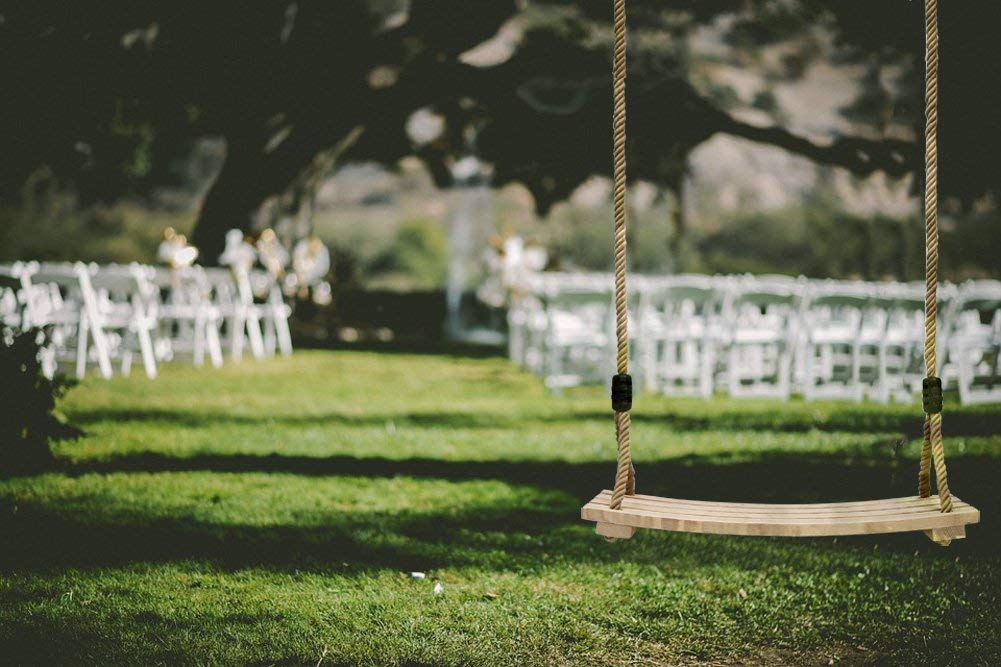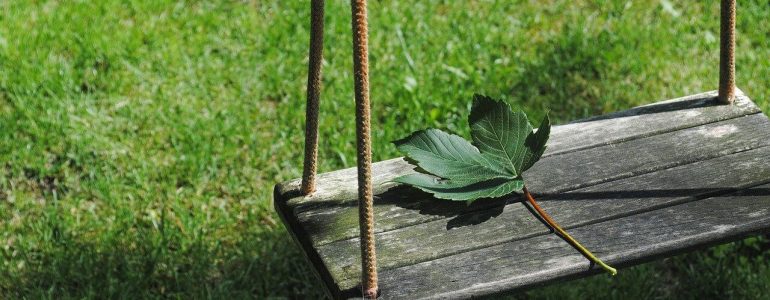Unless you have a metal frame or stand to hang a swing from, the best place to attach a swing outdoors is a tree branch.
Hanging a swing from a tree branch is easy and quick, as long as you find the right branch and you have a good quality tree swing with everything you need to hang it. Read on to learn more about how to attach a swing to a tree branch.
Choosing a Tree Branch

Before you hang the swing make sure you select a sturdy branch that is the right height off the ground.
If you have a hardwood tree like oak in your home, it’s the best. But any tree with sturdy branches will do.
Next, make sure the branch is sufficiently thick, at least 8” in diameter, to ensure it can hold someone’s weight.
If you are installing a large swing that can sit several kids, look for an even thicker and sturdier branch.
Next, check the clearance under the branch. If it is too low, it’ll make it harder to use the swing. If it is too high, it is a safety risk since the swing would swing too far forward and backward. You also don’t want the seat of the swing too high off the ground.
The ideal height from the ground depends on the length of the tree swing. Most kids tree swings come with ropes measuring 2-3m long.
Considering you need some of that length to wrap around the branch and that the seat will be about 50cm off the ground, the ideal branch height is 1.5-3m. If you are using hanging straps, meaning the rope doesn’t go round the branch, you can hang the swing from a higher branch (2-3.5m).
Most kids’ tree swings are adjustable. You can lengthen or shorten the ropes to get the perfect height based on the age of your child and how high the branch is.
If it is a DIY tree swing, you can of course make the ropes longer and hang the swing from a higher branch.
Don’t forget to check the condition of the branch. Rot, cracks and other injuries increase the risk of the branch snapping.
Also, make sure there are no obstructions around such as a structure or a tree stump. The trunk of the tree from which you hang the swing should be at least a metre away to ensure a child doesn’t bump into the tree.
Hanging the Swing
You’ll need two things to attach the swing to a branch: the swing itself and hanging straps. The straps go around the tree branch and have carabiners at the end to hang the swing from.
Most tree swings don’t come with the hanging straps, so make sure you buy a pair when you order the swing. But if you are replacing an old swing, you can use the same straps to hang the new swing.
Hang the straps around the branch and make sure they are tight and secure. Using the metal rings at the end of the swing, attach the swing ropes to the carabiners on the hanging straps.
Check the height of the seat, and if necessary, adjust it upwards or downwards. Your kid should be able to easily sit on the swing on their own.
With your child seated on the swing, give it a few pushes to make sure it’s working properly. Check that your child can easily stop the swing a get off on their own – that’s why the height of the seat is so important.
Safety Tips
- To protect the tree from damage, look for wide straps that won’t cut into the tree. Wide straps also distribute weight more effectively than a thin strap or rope.
- Check how well the swing is protected from the weather. Some manufacturers say you can safely leave the swing out all year round while others recommend taking it down in winter to keep the wooden seat from rotting.
- Every few months, check the condition of the branch to make sure it can still hold the weight. If there are signs of cracking or rotting, use another branch.
- Do not keep the same tree swing for more than a couple of years. Even high quality ropes deteriorate with time and weather exposure.
- Have a safe landing zone beneath the swing. Grass or bare ground free of rocks and tree roots is good.
- Regularly check the condition of the swing including the ropes, metal accessories and seat. Look for signs of fraying, rotting or some other kind of damage.









